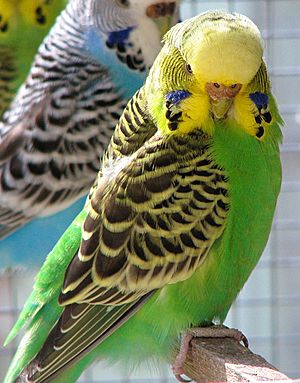Biological pigment facts for kids
A biological pigment is a special substance that gives living things their color. Think about why a plant is green or why a bird has bright feathers! These colors come from pigments.
Plants and animals use colors for many different reasons. These colors help them survive and interact with their environment. For example, the green color in plants comes from a pigment called chlorophyll. Chlorophyll helps plants capture sunlight. This sunlight energy is then used to make food through a process called photosynthesis.
Many colors in nature also help animals change their behavior. Some animals use their colors to hide from predators. This is called camouflage. Other animals use bright colors to warn predators that they are dangerous or taste bad. This is known as warning colouration. Colors can also help animals attract a partner or help plants attract insects for pollination.
A common dark pigment is called melanin. Melanin gives skin, hair, and eyes their color. It also helps protect living things from strong sunlight and harmful ultraviolet (UV) rays.
It's important to know that pigments are different from structural colors. Pigments look the same no matter what angle you view them from. Structural colors, however, are created by how light reflects off tiny structures on a surface. This means a structural color can look different when you view it from various angles. For example, a butterfly's wings might shimmer with different colors as you move around it. This is because of structural color, not pigments.
Contents
How Do Colors Help Living Things?
Colors for Survival
Colors play a huge role in how animals and plants survive. Imagine a chameleon changing its skin color to match a tree branch. This amazing trick is camouflage. It helps the chameleon hide from both predators and prey. Many insects also blend in with leaves or bark to stay safe.
Warning and Attraction Colors
Some animals use very bright, bold colors. These colors often act as a warning sign. For instance, a brightly colored frog might be poisonous. Predators learn to avoid these animals because of their striking colors. On the other hand, flowers use their vibrant colors to attract bees and other insects. These insects help the flowers reproduce by carrying pollen from one plant to another.
The Role of Melanin
Melanin is a very important pigment. It's found in almost all living things, including humans. In our skin, melanin helps protect us from sunburn. It absorbs harmful UV radiation from the sun. This is why people with more melanin in their skin tend to tan easily and are less likely to get sunburned.
Pigments Versus Structural Colors
Understanding Pigments
Pigments are like tiny colored particles. They absorb some colors of light and reflect others. The color we see is the light that is reflected. For example, a red apple has pigments that absorb all colors of light except red. The red light bounces off the apple and into our eyes. This is why the apple looks red.
What is Structural Color?
Structural color is different. It's not about what light is absorbed. Instead, it's about how light bounces off tiny, repeating patterns on a surface. Think of a soap bubble or a peacock feather. They seem to change color as you look at them from different angles. This happens because light waves interfere with each other as they reflect off these tiny structures. This creates a shimmering, iridescent effect.
Images for kids
-
This is a model of a chlorophyll molecule. It's the green pigment in plants.
-
Anthocyanin pigments give these pansies their beautiful purple color.
See also
 In Spanish: Pigmentos en seres vivos para niños
In Spanish: Pigmentos en seres vivos para niños




